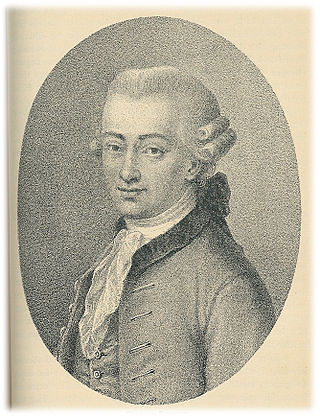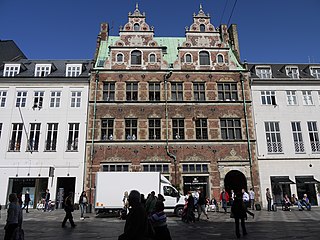Related Research Articles

Assistens Cemetery in Copenhagen, Denmark, is the burial site of many Danish notables as well as an important greenspace in the Nørrebro district. Inaugurated in 1760, it was originally a burial site for the poor laid out to relieve the crowded graveyards inside the walled city, but during the Golden Age in the first half of the 19th century it became fashionable and many leading figures of the epoch, such as Hans Christian Andersen, Søren Kierkegaard, Christoffer Wilhelm Eckersberg, and Christen Købke are all buried here.

Johan Peter Emilius Hartmann was, together with his son-in-law Niels W. Gade, the leading Danish composer of the 19th century, a period known as the Danish Golden Age. According to Alfred Einstein, he was "the real founder of the Romantic movement in Denmark and even in all Scandinavia". J.P.E. Hartmann was the third generation of composers in the Danish musical Hartmann family.

Johan Henrik Rye was a Norwegian military officer, jurist and elected official.

Gerhard Schøning was a Norwegian historian. His Reise som giennem en Deel af Norge i de Aar 1773, 1774, 1775 paa Hans Majestets Kongens Bekostning documenting travel through Trondheim, Gudbrandsdal and Hedmark, Norway in 1773–1775 has been recognized as both a historical reference and as a "minor travel classic."

Johan Martin Quist or Qvist was a Danish architect who made a significant contribution to the city of Copenhagen. Together with those of Andreas Hallander, his classically styled buildings form part of the legacy of 19th-century Danish Golden Age architects who reconstructed areas of the old town which had been destroyed in the Copenhagen Fire of 1795.
Johan Georg Ræder was a Norwegian military officer.
The Diocese of Zealand was a Protestant diocese in Denmark that existed from 1537 to 1922. The diocese had been formed in 1537 following the Reformation of Denmark, and was dissolved in 1922 when it was divided into the Diocese of Copenhagen and the Diocese of Roskilde. While it existed, the diocese functioned as the head of the Church of Denmark, beneath the crown, and its bishop was regarded as Primus inter pares.
Events from the year 1736 in Denmark.
Events from the year 1771 in Denmark.

Barchmann Mansion is a Baroque style town mansion overlooking Frederiksholm Canal in central Copenhagen, Denmark. Built in the early 1740s to designs by Philip de Lange, it is also known as the Wedell Mansion after the current owner. It was listed in the Danish registry of protected buildings and places in 1918. An extension from 1748 is now home to Johan Borup's Folk High School.

The Gustmeyer House is a historic property on Ved Stranden, opposite Christiansborg Palace on Slotsholmen, in central Copenhagen, Denmark. It was built in 1797 to a Neoclassical design by Johan Martin Quist. The Nobel Prize-winning physicist Niels Bohr was born in the building. McKinsey & Company is now based in the building.

Farumgård is a former manor house overlooking Farum Lake at Farum, Furesø Municipality, in the north-western outskirts of Copenhagen, Denmark. It is located just east of Farum Church and the original Farum village. The land has been sold off and redeveloped, except for the 6 hectares park which is laid out in the Baroque style.

The Matthias Hansen House, formerly also known as the Schoustrup House, is a Renaissance-style townhouse on Amagertorv in central Copenhagen, Denmark. Built in 1616, it is one of few buildings of its kind which has survived the Copenhagen Fires of 1728 and 1795. The building is now home to a flagship store for the Royal Copenhagen porcelain factory.
H.H. Thiele, also known as Det Thieleske Bogtrykkeri, was a Danish printing company based in Copenhagen, Denmark. It was known for its printing of high quality illustrations, and printed banknotes for the Bank of Denmark as well as postal stamps for the Royal Danish Mail.
Thiele is a chain of retail opticians headquartered in Copenhagen, Denmark. The company is owned by Jens Henrik Brandt (95%) and Profil Optik (5%).

Falkensteen is a manor house located five kilometres south of Slagelse, Denmark. The current Neoclassical main building was built for Georg Frederik Ditlev Koës in 1775. It was listed on the Danish registry of protected buildings and places in 1950. A half-timbered barn from 1864 is also listed.

Bianco Luno was a Danish book printer. His printing business, Bianco Lunos Bogtrykkeri, was at the time of his death in 1852 the largest company of its kind in Denmark. The street Bianco Lunos Allé in Frederiksberg is named after him.

Hof- og Stadsretten was a modern-style court of justice introduced in Denmark, specifically for Copenhagen, by Johann Friedrich Struensee in 1771. In 1805, it was merged with the new Landsoverret for Eastern Denmark as Den kongelige Landsoverret samt Hof- og Stadsret. It was replaced by the Københavns Byret and Østre Landsret in 1919.

Store Kongensgade 81 is a Neoclassical property situated in Store Kongensgade between Frederiksgade and Hindegade, in Copenhagen, Denmark. The complex consists of a Neoclassical residential building from the 1780s fronting the street and a number of somewhat older secondary wings, surrounding two consecutive courtyards, on its rear. It was listed in the Danish registry of protected buildings and places in 1918. The artist Lorenz Frølich, whose father and uncle owned the property for almost 50 years, spent his childhood at the site. Other notable former residents include former Governor-General of the Danish West Indies Frederik von Walterstorff, historian and social critic Niels Ditlev Riegels, physician Johan Daniel Herholdt (1764-1836) and painter August Schiøtt. The property is now owned by Jeudan.

The Gyldendal House, situated at Klareboderne 3, is the current headquarters of the Gyldendal publishing house in Copenhagen, Denmark. The 15-bays-long Baroque style town mansion was constructed by master mason and stucco artist Abraham Stoy in the 1740s. It was acquired by Gyldendal-founder Søren Gyldendal in 1787, and his publishing house has been headquartered in the building since then. A large new rear wing was constructed in the 1870s. The front wing was listed in the Danish registry of protected buildings and places in 1918.
References
- ↑ "Johan Rudolph Thiele" (in Danish). Dansk Biografisk Leksikon . Retrieved 22 August 2018.